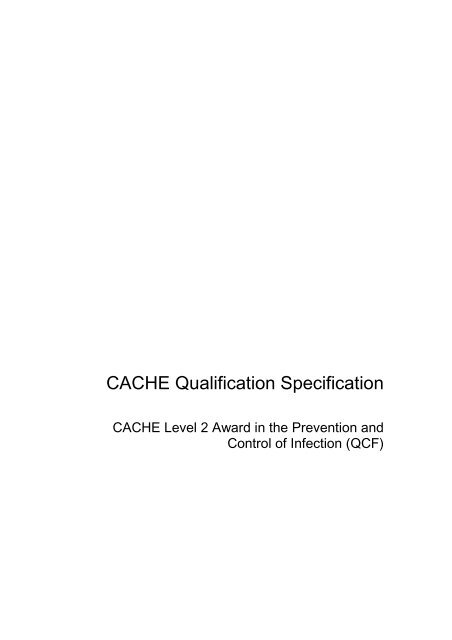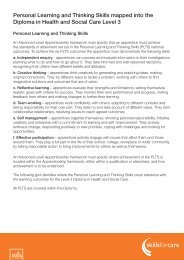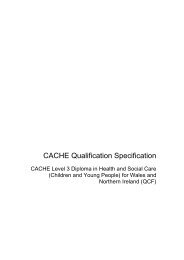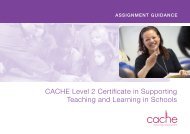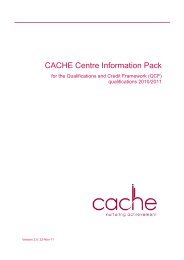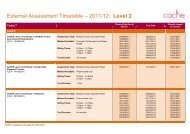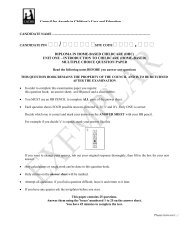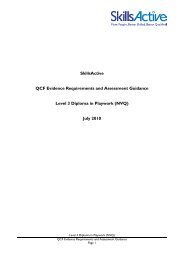CACHE Qualification Specification
CACHE Qualification Specification
CACHE Qualification Specification
You also want an ePaper? Increase the reach of your titles
YUMPU automatically turns print PDFs into web optimized ePapers that Google loves.
<strong>CACHE</strong> <strong>Qualification</strong> <strong>Specification</strong><strong>CACHE</strong> Level 2 Award in the Prevention andControl of Infection (QCF)
<strong>CACHE</strong> Level 2 Award in the Prevention and Control of Infection (QCF)<strong>CACHE</strong> © Copyright 2013 All rights reserved worldwide.Reproduction by approved <strong>CACHE</strong> centres is permissible for internal use under the followingconditions:<strong>CACHE</strong> has provided this <strong>Qualification</strong> <strong>Specification</strong> in Microsoft Word format to enable its Centres touse its content more flexibly within their own course materials. You may copy and paste any materialfrom this document; however, <strong>CACHE</strong> does not accept any liability for any incomplete or inaccuratecopying and subsequent use of this information. The use of PDF versions of our support materials onthe <strong>CACHE</strong> website will ensure that correct and up-to-date information is provided to learners.Any photographs in this publication are the exclusive property of <strong>CACHE</strong> . They are protected undercopyright law and cannot be reproduced, copied or manipulated in any form. This includes the use ofany image or part of an image in individual or group projects and assessment materials. All images havea signed model release.<strong>Qualification</strong> reference numbers:Level 2 Award in the Prevention and Control of Infection (QCF) 600/3096/3Published in Great Britain by <strong>CACHE</strong>First edition 2011 Book code N/APublication dateVersion 1.0 August 2011Version 2.0 September 2011Version 3.0 July 2012Version 4.0 May 2013PublisherCouncil for Awards in Care, Health and EducationApex House81 Camp RoadSt AlbansHertfordshireAL1 5GBTelephone: 0345 347 2123Registered Company No: 2887166Registered Charity No: 1036232© <strong>CACHE</strong> 2013 Version 4.0 2
<strong>Qualification</strong> <strong>Specification</strong>ContentsSection 1: General introduction 5About this <strong>Qualification</strong> <strong>Specification</strong> 6How the qualification works 6Understanding learning outcomes 7Making use of the <strong>CACHE</strong> websites 8The Public Website 8The Centre Secure Website 8Section 2: About this qualification 9<strong>Qualification</strong> summary 10<strong>CACHE</strong> Level 2 Award in the Prevention and Control of Infection (QCF) 10Introduction to this qualification 12Rules of combination 13Progression 13Unit achievement log 14Section 3: Units 15Assessment Methods 16Unit layout 17IC 01: The principles of infection prevention and control 19IC 02: Causes and spread of infection 25IC 03: Cleaning, decontamination and waste management 29Section 4: Assessment and quality assurance information for tutors and assessors 33Assessment guidance 34<strong>CACHE</strong> Assessment Strategy 35Section 5: Feedback 37QCF Support Materials Feedback Form 39Section 6: Documents 41Useful documents 41© <strong>CACHE</strong> 2013 Version 4.0 3
<strong>CACHE</strong> Level 2 Award in the Prevention and Control of Infection (QCF)Mandatory documents 41Section 7: Publication history 43© <strong>CACHE</strong> 2013 Version 4.0 4
Section 1: General introduction© <strong>CACHE</strong> 2013 Version 4.0 5
Section 1: General introductionAbout this <strong>Qualification</strong> <strong>Specification</strong>This <strong>Qualification</strong> <strong>Specification</strong> contains all the units and assessments you will need tocomplete to gain the qualification. Your tutor or assessor will either supply you with copies ofyour chosen units or direct you to the relevant page on the website so you can download them.This <strong>Specification</strong> also contains extra information for your tutor or assessor.How the qualification worksThis qualification is made up of units each representing a small step of learning. This allows thequalification to be completed at your own pace.All of the units achieved can be ‘banked’. This means that if you want to take anotherqualification which includes the same units you do not have to take them again.Each unit has:• a level - shows how difficult it is• a credit value - one credit represents about 10 hours' work• a unit aim – explains what is covered in the unit• learning outcomes – cover what you need to do (skills) or what you need tounderstand (knowledge)• assessment criteria – what you need to show (evidence)Each learning outcome is linked to a number of assessmentcriteria. Evidence must be provided for all the assessmentcriteria to gain the unit.Example shows how outcomes and criteria are laid out in the Unit Assessment Records (UARs) in Section 3© <strong>CACHE</strong> 2013 Version 4.0 6
Section 1: General introductionUnderstanding learning outcomesThere are two main types of learning outcome:• Skills that can be performed• Knowledge that can be learnt.Sometimes they can cover a combination of the two.Competence / Skills based learning outcomes:• generally begin with ‘Be able to’ and the assessment criteria usually show that theevidence must be observable• are about being able to perform a variety of different tasks as part of your work rolewithin a real work environment.Knowledge based learning outcomes:• generally begin with ‘Know’, ‘Understand’ or ‘Know how to’ and the assessmentcriteria will reflect that evidence can be recorded in ways other than observation,although observation remains a valid method (however, some learning outcomescould be purely knowledge based and do not need to be in the context of a workrole).For your convenience, Knowledge-only units are indicated by a lightbulb in both theUnit Achievement Log and at the top of the units.If a unit is not marked with a lightbulb, a unit has some Skills/Competencecomponent(s).© <strong>CACHE</strong> 2013 Version 4.0 7
Section 1: General introductionMaking use of the <strong>CACHE</strong> websitesThe <strong>CACHE</strong> websites are maintained on a regular basis and this is where the most up to datedocuments can be found. We strongly advise that these should be used as a resource on anon-going basis to ensure you always have the most current information.All our qualification documents are version controlled, allowing you to check for updates orrevisions.The Public WebsiteOur public website address is: www.cache.org.uk and contains information that is available toeverybody. It contains information about all our qualifications, including:• Key Facts• <strong>Qualification</strong> <strong>Specification</strong>sThere are also some other key documents that can be referred to when required. For example:• Complaints Procedure• Appeals Process• Equality and Diversity Statement – our approach to non-discrimination• <strong>CACHE</strong> Statement of Values – our values when working with children or youngpeopleIt also contains regular news updates and case studies and links to websites from otherorganisations that might be of interest.The Centre Secure WebsiteMore specific information to support Centre delivery can be found on our secure website‘cachezone’. This site is for Centres only.Login is via the ‘cachezone page’ on our public website using the details provided by theCentre administrator.© <strong>CACHE</strong> 2013 Version 4.0 8
Section 2: About this qualification© <strong>CACHE</strong> 2013 Version 4.0 9
Section 2: About this qualification<strong>Qualification</strong> summaryTitleType<strong>CACHE</strong> Level 2 Award in the Prevention and Control of Infection (QCF)QCF<strong>Qualification</strong> number 600/3096/3AimPurposeOfqual code and description(where applicable)The qualification aims to build on learners’ knowledge and awareness ofthe prevention and control of infection for those working in health settingsand adult or child social care settings. It is aimed at learners in school orcollege, or those working for local authorities or private commercialhomeowners.Learners will develop an understanding of methods of preventing andcontrolling infection, allowing for progression to the Level 2 Diploma inHealth and Social Care. It may also allow learners to progress intoemployment in Health settings, or Adult and Child Social Care settings.B. Prepare for further learning or training and/or develop knowledge and/orskills in a subject areaB2. Develop knowledge and/or skills in a subject areaGuided learning hours Min 70 Max 70Credit value 7 Minimum credits at / above Level 7Minimum age of learner 14Age ranges covered bythe qualificationReal work environment(RWE) requirement /recommendationRules of CombinationProgressionEquivalencies /Performance PointsRecommendedassessment methodsN/AThis is a knowledge only qualification; therefore, work experience is notmandatory.To gain this qualification, learners must achieve the 3 mandatory units.The units of the Level 2 Award are embedded in the Level 2 Diploma inHealth and Social Care. As such, learners could progress directly to theDiploma, which in turn would allow them to register on the Health andSocial Care apprenticeship. Although not confirming occupationalcompetence, it would aid progression into the workplace as it is anemployer requirement in all Health settings.For information on Equivalencies and Performance Points for <strong>CACHE</strong>qualifications, please refer to the <strong>CACHE</strong> document “QCF Equivalenciesand Performance Points” on the <strong>CACHE</strong> website and cachezone.All units will be individually internally assessed using a range of methodswhich could include: written assignments or tasks* such as designing aleaflet or booklet, charts or diagrams or setting up an information board.* NB: <strong>CACHE</strong> assessment task are provided for tutors’ convenience. They are not mandatory.© <strong>CACHE</strong> 2013 Version 4.0 10
Section 2: About this qualificationAdditional assessmentrequirementsGrading systemHow long will it take tocomplete?Entry requirements /recommendationsAll units must be assessed in line with the <strong>CACHE</strong> QCF AssessmentPrinciples.The qualification will be pass or refer and all the assessment criteria forthe chosen units must be achieved in order to obtain a pass.The qualification can usually be completed in less than 6 months.Learners must be at least 14 years of age.© <strong>CACHE</strong> 2013 Version 4.0 11
Section 2: About this qualificationIntroduction to this qualificationLevel 2 Award in the Prevention and Control of InfectionLearners wishing to work in the Health sector are required to have training or a qualification inthe prevention and control of infection; thus with the advent of QCF, Skills for Health fasttrackedthe development of an Award in the Prevention and Control of Infection (QCF)qualification to replace the NQF provision.The qualification aims to build on learners’ knowledge and awareness of the prevention andcontrol of infection for those working in health settings and adult or child social care settings. Itis aimed at learners in school or college, or those working for local authorities or privatecommercial homeowners.Learners will develop an understanding of methods of preventing and controlling infection,allowing for progression to Level 2 Health and Social Care qualifications, or employment inAdult Social Care and Childcare settings.© <strong>CACHE</strong> 2013 Version 4.0 12
Section 2: About this qualificationRules of combinationTo gain this qualification, learners must achieve the 3 mandatory units.ProgressionLevel 2 Award in the Prevention and Control of InfectionThe units of the Level 2 Award are embedded in the Level 2 Diploma in Health and SocialCare. As such, learners could progress directly to the Diploma, which in turn would allow themto register on the Health and Social Care apprenticeship. Although not confirming occupationalcompetence, the Award would aid progression into the workplace as it is an employerrequirement in all Health settings.© <strong>CACHE</strong> 2013 Version 4.0 13
Section 2: About this qualificationUnit achievement logUnit no. Unit ref. Unit title Unit type Level Credit GLH Page NotesIC 01 L/501/6737 The principles of infection prevention and control Knowledge/Skills2 3 30 19IC 02 H/501/7103 Causes and spread of infection Knowledge 2 2 20 25IC 03 R/501/6738 Cleaning, decontamination and waste management Knowledge 2 2 20 29Total credit and GLH for Mandatory Units 7 70© <strong>CACHE</strong> 2013 Version 4.0 14
Section 3: UnitsThis section includes <strong>CACHE</strong> assessment tasks for tutors’ convenience.They are not mandatory.© <strong>CACHE</strong> 2013 Version 4.0 15
Section 3: UnitsAssessment MethodsPlease note that the following assessment methods can be applied across knowledge onlyassessment criteria and the optional task devised by <strong>CACHE</strong> is an example of one suchmethod. Practical placement is not a requirement for this qualification, however it is a viablemethod should the opportunity arise.• Direct observation• Professional discussion• Expert Witness evidence• Learner’s own work products• Learner log or reflective diary• Activity plan or planned activity• Observation of children, young people or adults by the learner• Portfolio of evidence• Recognition of Prior Learning to evidence a full unit• Reflection on own practice in real work environment• Written and pictorial information• Scenario or case study• Task set by <strong>CACHE</strong> (for knowledge learning outcomes)• Oral questions and answers• Non-compulsory assessment method devised by centre and approved by <strong>CACHE</strong>.© <strong>CACHE</strong> 2013 Version 4.0 16
Section 3: UnitsUnit layoutFor each unit the following material has been provided:Unit titleUnit numberUnit referenceUnit levelUnit credit valueProvides a clear, concise explanation of the content of the unit.The unique number assigned by the owner of the unit (e.g.Edexcel, <strong>CACHE</strong> etc.).The unique reference number given to each unit at qualificationapproval by Ofqual.Denotes the level of the unit within the QCF framework.The value that has been given to the unit based on the expectedlearning time for an average learner.1 credit = 10 learning hours.Unit aimLearning outcomeAssessment criteriaAdditional information*Unit assessment guidance*Unit guided learning hoursAssessment task (set by<strong>CACHE</strong>)*Provides a brief outline of the unit content.A statement of what a learner will know, understand or be able todo, as a result of a process of learning.A description of the requirements a learner must achieve todemonstrate that a learning outcome has been met.This box identifies the assessment strategy relevant to the unit.When required, this will include specific guidance relating to theassessment of the unit and information to support the learner toachieve.Any additional guidance provided to support the assessment ofthe unit.The average number of hours of supervised or directed studytime or assessment required to achieve a qualification or unit of aqualification.A scenario or aspect of the work role that will support the learnerin producing the evidence requirements for knowledge onlylearning outcomes.* Additional information, Unit assessment guidance and Assessment tasks may not be provided for all units.NB: Words highlighted in bold in the learning outcomes, assessment criteria and assessmenttasks are linked to the additional guidance section where more information on them can befound.© <strong>CACHE</strong> 2013 Version 4.0 17
IC 01: The principles of infection prevention and controlIC 01: The principles of infection prevention and controlUnit reference L/501/6737 Level 2Credit value 3 GLH 30Unit aimTo introduce the learner to national and local policies in relation toinfection control; to explain employer and employee responsibilities in thisarea; to understand how procedures and risk assessment can helpminimise the risk of an outbreak of infection. Learners will also gain anunderstanding of how to use PPE correctly and the importance of goodpersonal hygiene.Learner name:<strong>CACHE</strong> Centre no:<strong>CACHE</strong> PIN:ULN:Learning outcomesThe learner will:Assessment criteriaThe learner can:Evidencerecorde.g. pagenumber &methodAssessorjudgementachievedInitial and date1. Understand roles andresponsibilities in theprevention and control ofinfections.1.1. Explain employees’ roles andresponsibilities in relation tothe prevention and control ofinfection.1.2. Explain employers’responsibilities in relation tothe prevention and control ofinfection.2. Understand legislation andpolicies relating toprevention and control ofinfections.2.1. Outline current legislation andregulatory body standardswhich are relevant to theprevention and control ofinfection.2.2. Describe local andorganisational policies relevantto the prevention and control ofinfection.3. Understand systems andprocedures relating to theprevention and control ofinfections.3.1. Describe procedures andsystems relevant to theprevention and control ofinfection.© <strong>CACHE</strong> 2013 Version 4.0 19
IC 01: The principles of infection prevention and controlLearning outcomesThe learner will:Assessment criteriaThe learner can:Evidencerecorde.g. pagenumber &methodAssessorjudgementachievedInitial and date3.2. Explain the potential impact ofan outbreak of infection on theindividual and the organisation.4. Understand the importanceof risk assessment inrelation to the preventionand control of infections.4.1. Define the term risk.4.2. Outline potential risks ofinfection within the workplace.4.3. Describe the process ofcarrying out a risk assessment.4.4. Explain the importance ofcarrying out a risk assessment.5. Understand the importanceof using PersonalProtective Equipment(PPE) in the prevention andcontrol of infections.5.1. Demonstrate correct use ofPPE.5.2. Describe different types ofPPE.5.3. Explain the reasons for use ofPPE.5.4. State current relevantregulations and legislationrelating to PPE.5.4. Describe employees’responsibilities regarding theuse of PPE.5.6. Describe employers’responsibilities regarding theuse of PPE.5.7. Describe the correct practicein the application and removalof PPE.5.8. Describe the correct procedurefor disposal of used PPE.© <strong>CACHE</strong> 2013 Version 4.0 20
IC 01: The principles of infection prevention and controlLearning outcomesThe learner will:Assessment criteriaThe learner can:Evidencerecorde.g. pagenumber &methodAssessorjudgementachievedInitial and date6. Understand the importanceof good personal hygiene inthe prevention and controlof infections.6.1. Describe the key principles ofgood personal hygiene.6.2. Demonstrate good handwashing technique.6.3. Describe the correct sequencefor hand washing.6.4. Explain when and why handwashing should be carried out.6.5. Describe the types of productsthat should be used for handwashing.6.6. Describe correct proceduresthat relate to skincare.Learner declaration of authenticity:I declare that the work presented for this unit is entirely my own work.Learner signature:Date:Assessor sign off of completed unit: IC01I confirm that the learner has met the requirements for all assessment criteria demonstratingknowledge and skills for this unit.Assessor name:Signature:Date:For e-portfolio a signature is not required, providing the learner has a personalised and secure login.© <strong>CACHE</strong> 2013 Version 4.0 21
IC 01: The principles of infection prevention and controlAdditional information about the unit:Relationship to occupational standards –provided with the QCF unitThere are some relationships between this unit andthose of other standards such as Key Skills, FunctionalSkills and Skills for Life.This unit is based upon the Skills for Health InfectionControl workplace competencies.Additional unit assessment requirementsprovided with the QCF unitThis unit needs to be assessed in line with the <strong>CACHE</strong>QCF Assessment Principles.© <strong>CACHE</strong> 2013 Version 4.0 22
IC 01: The principles of infection prevention and controlAssessment Task – IC 01The principles of infection prevention and controlIn your place of work, as a worker you are responsible for infection prevention and control inyour daily routine. You have been asked by your manager to prepare a wall display for an openday for the general public which shows that you can:Task 1 links to learning outcome 1, assessment criteria 1.1 and 1.2.• explain employees’ roles and responsibilities in relation to the prevention and controlof infection• explain employers’ responsibilities in relation to the prevention and control of infectionTask 2 links to learning outcome 2, assessment criteria 2.1 and 2.2.• outline current legislation and regulatory body standards which are relevant to theprevention and control of infection• describe local and organisational policies relevant to the prevention and control ofinfectionTask 3 links to learning outcome 3, assessment criteria 3.1 and 3.2.• describe procedures and systems relevant to the prevention and control of infection• explain the potential impact of an outbreak of infection on the individual and theorganisationTask 4 links to learning outcome 4, assessment criteria 4.1, 4.2, 4.3 and 4.4.• define the term risk• outline potential risks of infection within the workplace• describe the process of carrying out a risk assessment• explain the importance of carrying out a risk assessmentTask 5 links to learning outcome 5, assessment criteria 5.1, 5.2, 5.3, 5.4, 5.5, 5.6, 5.7 and 5.8.• demonstrate correct use of PPE• describe different types of PPE• explain the reasons for use of PPE• state current relevant regulations and legislation relating to PPE• describe employees’ responsibilities regarding the use of PPE• describe employers’ responsibilities regarding the use of PPE• describe the correct practice in the application and removal of PPE• describe the correct procedure for disposal of used PPE© <strong>CACHE</strong> 2013 Version 4.0 23
IC 01: The principles of infection prevention and controlTask 6 links to learning outcome 6, assessment criteria 6.1, 6.2, 6.3, 6.4, 6.5 and 6.6.• describe the key principles of good personal hygiene• demonstrate good hand washing technique• describe the correct sequence for hand washing• explain when and why hand washing should be carried out• describe the types of products that should be used for hand washing• describe correct procedures that relate to skincare.© <strong>CACHE</strong> 2013 Version 4.0 24
IC 02: Causes and spread of infectionIC 02: Causes and spread of infectionUnit reference H/501/7103 Level 2Credit value 2 GLH 20Unit aimThis unit is to enable the learner to understand the causes of infectionand common illnesses that may result as a consequence. To understandthe difference between infection and colonisation and pathogenic andnon-pathogenic organisms, the areas of infection and the types causedby different organisms. In addition the learner will understand themethods of transmission, the conditions needed for organisms to grow,the ways infections enter the body and key factors that may lead toinfection occurring.Learner name:<strong>CACHE</strong> Centre no:<strong>CACHE</strong> PIN:ULN:Learning outcomesThe learner will:Assessment criteriaThe learner can:Evidencerecorde.g. pagenumber &methodAssessorjudgementachievedInitial and date1. Understand the causes ofinfection.1.1. Identify the differencesbetween bacteria, viruses,fungi and parasites.1.2. Identify common illnesses andinfections caused by bacteria,viruses, fungi and parasites.1.3. Describe what is meant by“infection and colonisation.”1.4. Explain what is meant by“systemic infection” and“localised infection.”1.5. Identify poor practices thatmay lead to the spread ofinfection.© <strong>CACHE</strong> 2013 Version 4.0 25
IC 02: Causes and spread of infectionLearning outcomesThe learner will:Assessment criteriaThe learner can:Evidencerecorde.g. pagenumber &methodAssessorjudgementachievedInitial and date2. Understand thetransmission of infection.2.1. Explain the conditions neededfor the growth of microorganisms.2.2. Explain the ways an infectiveagent might enter the body.2.3. Identify common sources ofinfection.2.4. Explain how infective agentscan be transmitted to a person.2.5. Identify the key factors that willmake it more likelythat infection will occur.Learner declaration of authenticity:I declare that the work presented for this unit is entirely my own work.Learner signature:Date:Assessor sign off of completed unit: IC02I confirm that the learner has met the requirements for all assessment criteria demonstratingknowledge and skills for this unit.Assessor name:Signature:Date:For e-portfolio a signature is not required, providing the learner has a personalised and secure login.© <strong>CACHE</strong> 2013 Version 4.0 26
IC 02: Causes and spread of infectionAdditional information about the unit:Relationship to occupational standards –provided with the QCF unitAdditional unit assessment requirementsprovided with the QCF unitThere are some relationships between this unit andthose of other standards such as Key Skills, FunctionalSkills and Skills for Life.Health and Social Care NVQ level 2 unit HCS22Health NVQ level 2 unit GEN 3.Core dimension 3: Health, safety and security – Monitorand maintain health, safety and security of others.Infection Control NOS.This unit needs to be assessed in line with the <strong>CACHE</strong>QCF Assessment Principles.© <strong>CACHE</strong> 2013 Version 4.0 27
IC 02: Causes and spread of infectionAssessment Task – IC 02 Causes and spread of infectionYou have been asked to develop a poster to inform your peers about the causes and spread ofinfection. The poster will be displayed in common rooms and public areas in your place of work.The poster should:Task 1 links to learning outcome 1, assessment criteria 1.1, 1.2, 1.3, 1.4 and 1.5.• identify the differences between bacteria, viruses, fungi and parasites• identify common illnesses and infections caused by bacteria, viruses, fungi andparasites• describe what is meant by “infection and colonisation”• explain what is meant by “systemic infection” and “localised infection”• identify poor practices that may lead to the spread of infectionTask 2 links to learning outcome 2, assessment criteria 2.1, 2.2, 2.3, 2.4 and 2.5.• explain the conditions needed for the growth of micro-organisms• explain the ways an infective agent might enter the body• identify common sources of infection• explain how infective agents can be transmitted to a person• identify the key factors that will make it more likely that infection will occur.© <strong>CACHE</strong> 2013 Version 4.0 28
IC 03: Cleaning, decontamination and waste managementIC 03: Cleaning, decontamination and wastemanagementUnit reference R/501/6738 Level 2Credit value 2 GLH 20Unit aimTo explain to the learner the correct way of maintaining a cleanenvironment in accordance with national policies; to understand theprocedures to follow to decontaminate an area from infection; and toexplain good practice when dealing with waste materials.This unit does not cover the decontamination of surgical instruments.Learner name:<strong>CACHE</strong> Centre no:<strong>CACHE</strong> PIN:ULN:Learning outcomesThe learner will:Assessment criteriaThe learner can:Evidencerecorde.g. pagenumber &methodAssessorjudgementachievedInitial and date1. Understand how tomaintain a cleanenvironment to prevent thespread of infection.1.1. State the general principles forenvironmental cleaning.1.2. Explain the purpose ofcleaning schedules.1.3. Describe how the correctmanagement of theenvironment minimises thespread of infection.1.4. Explain the reason for thenational policy for colourcoding of cleaning equipment.2. Understand the principlesand steps of thedecontamination process.2.1. Describe the three steps of thedecontamination process.2.2. Describe how and whencleaning agents are used.2.3. Describe how and whendisinfecting agents are used.© <strong>CACHE</strong> 2013 Version 4.0 29
IC 03: Cleaning, decontamination and waste managementLearning outcomesThe learner will:Assessment criteriaThe learner can:Evidencerecorde.g. pagenumber &methodAssessorjudgementachievedInitial and date2.4. Explain the role of personalprotective equipment (PPE)during the decontaminationprocess.2.5. Explain the concept of risk indealing with specific types ofcontamination.2.6. Explain how the level of riskdetermines the type of agentthat may be used todecontaminate.2.7. Describe how equipmentshould be cleaned and stored.3. Understand the importanceof good waste managementpractice in the prevention ofthe spread of infection.3.1. Identify the different categoriesof waste and the associatedrisks.3.2. Explain how to dispose of thedifferent types of waste safelyand without risk to others.3.3. Explain how waste should bestored prior to collection.3.4. Identify the legalresponsibilities in relation towaste management.3.5. State how to reduce the risk ofsharps injury.© <strong>CACHE</strong> 2013 Version 4.0 30
IC 03: Cleaning, decontamination and waste managementLearner declaration of authenticity:I declare that the work presented for this unit is entirely my own work.Learner signature:Date:Assessor sign off of completed unit: IC03I confirm that the learner has met the requirements for all assessment criteria demonstratingknowledge and skills for this unit.Assessor name:Signature:Date:For e-portfolio a signature is not required, providing the learner has a personalised and secure login.Additional information about the unit:Relationship to occupational standards –provided with the QCF unitAdditional unit assessment requirementsprovided with the QCF unitThere are some relationships between this unit andthose of other standards such as Key Skills,Functional Skills and Skills for Life.General Healthcare Competence GEN3. Maintainhealth and safety in a clinical/therapeuticenvironment (K5).Knowledge and Skills Framework Core 3 Healthsafety and Security.Health and Social Care NOS HSC246, 230, 0032.Infection Prevention and Control NOS IPC1, 3,4,6,7.This unit needs to be assessed in line with the <strong>CACHE</strong>QCF Assessment Principles.© <strong>CACHE</strong> 2013 Version 4.0 31
IC 03: Cleaning, decontamination and waste managementAssessment Task – IC 03 Cleaning, decontamination and wastemanagementYour place of work has just contracted the cleaning to a new outside firm of cleaners. You havebeen asked to design a handy hints leaflet for them that shows that you can:Task 1 links to learning outcome 1, assessment criteria 1.1, 1.2, 1.3 and 1.4.• state the general principles for environmental cleaning• explain the purpose of cleaning schedules• describe how the correct management of the environment minimises the spread ofinfection• explain the reason for the national policy for colour coding of cleaning equipmentTask 2 links to learning outcome 2, assessment criteria 2.1, 2.2, 2.3, 2.4, 2.5, 2.6 and 2.7.• describe the three steps of the decontamination process• describe how and when cleaning agents are used• describe how and when disinfecting agents are used• explain the role of personal protective equipment (PPE) during the decontaminationprocess• explain the concept of risk in dealing with specific types of contamination• explain how the level of risk determines the type of agent that may be used todecontaminate• describe how equipment should be cleaned and storedTask 3 links to learning outcome 3, assessment criteria 3.1, 3.2, 3.3, 3.4 and 3.5.• identify the different categories of waste and the associated risks• explain how to dispose of the different types of waste safely and without risk to others• explain how waste should be stored prior to collection• identify the legal responsibilities in relation to waste management• state how to reduce the risk of sharps injury.© <strong>CACHE</strong> 2013 Version 4.0 32
Section 4: Assessment and qualityassurance information for tutors andassessors© <strong>CACHE</strong> 2013 Version 4.0 33
Section 4: Assessment and quality assurance information for tutors and assessorsAssessment guidanceA recommended range of assessment methods has been identified for the units in thisqualification. This gives the opportunity for different learning styles and individual needs oflearners to be taken into account.Recommended range of assessment methods for this qualificationOne of the following assessment methods can be chosen to produce evidence.For Knowledge only learning outcomes:• Written and pictorial information• Scenario or case study• Task set by <strong>CACHE</strong>• Oral questions and answers• Assessment method devised by Centre and approved by <strong>CACHE</strong>If you are proposing to use an assessment method that is not included within therecommended list you should contact your Centre Quality Advisor with full details of yourproposed method. It will need formal approval from us before it can be used.A key to the recommended assessment methods is included in “How to … A Guide toAssessing <strong>CACHE</strong> QCF <strong>Qualification</strong>s”, which can be found on cachezone.© <strong>CACHE</strong> 2013 Version 4.0 34
Section 4: Assessment and quality assurance information for tutors and assessorsAssessment strategies and principles relevant to thisqualificationThe units we offer have been developed in line with the specific assessment strategies orprinciples of different Sector Skills Councils (SSCs) or by <strong>CACHE</strong> where there is no SSC lead.The key requirements of the assessment strategies or principles that relate to units in thisqualification are summarised below. More detailed strategies or principles can be found in the“How to … A Guide to Understanding the Requirements of Assessors and Internal QualityAssurers for <strong>CACHE</strong> QCF <strong>Qualification</strong>s”.The Centre needs to ensure that individuals undertaking assessor or quality assurer roleswithin your Centre conform to the <strong>CACHE</strong> assessment requirements for the unit they areassessing or quality assuring.<strong>CACHE</strong> Assessment StrategyKnowledge learning outcomes• Assessors will need to be both occupationally knowledgeable and qualified to makeassessment decisions• Internal Quality Assurers need to be both occupationally knowledgeable andqualified to make quality assurance decisionsCompetence / Skills learning outcomes• Assessors will need to be both occupationally competent and qualified to makeassessment decisions• Internal Quality Assurers will need to be both occupationally knowledgeable andqualified to make quality assurance decisions© <strong>CACHE</strong> 2013 Version 4.0 35
Section 5: Feedback© <strong>CACHE</strong> 2013 Version 4.0 37
Section 5: FeedbackTell us what you think!Your feedback is really important to us.Please take a few moments to tell us how well this document supports you when teaching orstudying this qualification.The form is also available as a separate document on cachezone.© <strong>CACHE</strong> 2013 Version 4.0 38
Section 5: FeedbackQCF Support Materials Feedback Form<strong>Qualification</strong>:<strong>CACHE</strong> Level 2 Award in the Prevention and Control of Infection (QCF)Name: Are you: a Tutor / a LearnerCentre name:Centre no.:Contact details: *Tel.:Email:Please rate the following statements on a scale of 1-3:1 Disagree 2 Tend to agree 3 Agree1 2 31. This document is presented in a clear and accessible way and Ican easily find the information I need.2. This document contains all the information I need to teach orstudy this qualification.3. The language used throughout this document is clear,unambiguous and appropriate for both tutors and learners.4. Tutors only. This document has had a positive effect on the way Ideliver this qualification.Please use the space below to provide more detailed comments or additional feedback* Please indicate if you would like us to contact you about your feedback Yes / NoPlease email your completed feedback form to: qcfsupportmaterials@cache.org.ukAlternatively, you may post or fax your form to:<strong>CACHE</strong> QCF Support Materials,<strong>CACHE</strong>, Apex House,81 Camp Road, St. Albans, Herts. AL1 5GBFax: 01727 818613© <strong>CACHE</strong> 2013 Version 4.0 39
Section 6: DocumentsUseful documentsThis section refers to useful documents that can be found on the secure cachezone system,some of which may assist with the delivery of this qualification.• How to Guide to Assessing <strong>CACHE</strong> QCF <strong>Qualification</strong>s• <strong>CACHE</strong> How to - Requirements of Assessors and Internal Quality Assurers• QCF Glossary (Skills for Health)Mandatory documentsThe completion of an ‘Evidence Record’ and ‘Record of Assessment Cycle’ form is mandatory.<strong>CACHE</strong> has devised these templates for your convenience; however, you may design yourown forms which comply with the content of the <strong>CACHE</strong> templates.• <strong>CACHE</strong> Evidence Record• <strong>CACHE</strong> Record of Assessment CycleWe have also provided notes to guide you when completing these forms:• Completing the <strong>CACHE</strong> Evidence Record• Completing the <strong>CACHE</strong> Record of Assessment Cycle© <strong>CACHE</strong> 2013 Version 4.0 41
Section 7: Publication historyA comprehensive <strong>CACHE</strong> QCF Support Materials Publication History, including details ofchanges made to all <strong>CACHE</strong> QCF support materials since 2010, is available on cachezone.© <strong>CACHE</strong> 2013 Version 4.0 43


